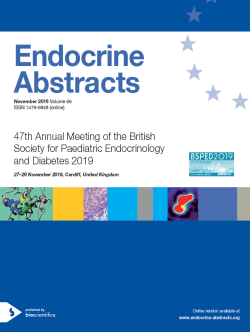Searchable abstracts of presentations at key conferences in endocrinology

47th Meeting of the British Society for Paediatric Endocrinology and Diabetes
Cardiff,
UK
27 Nov 2019 - 29 Nov 2019

BSPED 2019, 27 - 29 November 2019; Cardiff, UK
Contents
- 47th Annual Meeting of the British Society for Paediatric Endocrinology and Diabetes 2019
-
- CME TRAINING DAY SESSIONS
- Session 1
-
-
ea0066cme1.1
-
ea0066cme1.2
-
- Session 2
-
-
ea0066cme2.2
- Session 3
-
-
ea0066cme3.1
-
ea0066cme3.2
-
- Session 4
-
-
ea0066cme4.1
-
ea0066cme4.2
-
- MAIN SYMPOSIA
-
- Endocrine Track 1: Symposium 1
-
-
ea0066s1.1
-
ea0066s1.2
-
- Endocrine Track 1: Symposium 2
-
-
ea0066s2.1
-
- Diabetes Track 1: Symposium 3
-
-
ea0066s3.1
-
- Diabetes Track 1: Symposium 4
-
-
ea0066s4.1
-
- Nurses' Day for Endocrine Professionals: Symposium 5
-
-
ea0066s5.1
-
ea0066s5.2
-
ea0066s5.3
-
- DEBATE: SPEAKER BIOGRAPHIES
-
- (1)
-
-
ea0066d1.1
-
ea0066d1.2
-
- INQUISITOR SESSION: SPEAKER BIOGRAPHIES
-
- (1)
-
-
ea0066in1.1
-
ea0066in1.2
-
- PENS PRESENTATION
-
- (1)
-
-
ea0066pens1.2
-
ea0066pens1.3
- DIABETES PROFESSIONALS' DAY SESSIONS
- NURSES' DAY FOR ENDOCRINE PROFESSIONALS SESSIONS
- ORAL COMMUNICATIONS
- Poster Presentations
-
- Adrenal, Gonadal, DSD and Reproduction, and Basic Science
-
- Bone
-
-
ea0066p12
-
ea0066p15
- Diabetes 1
-
- Diabetes 2
-
- Diabetes 3
-
- Diabetes 4
-
-
ea0066p40
-
- Diabetes 5
-
- Diabetes 6
-
- Learning from Mistakes and Miscellaneous
-
-
ea0066p64
-
ea0066p65
- Pituitary
-
- Thyroid
-
-
ea0066p81



